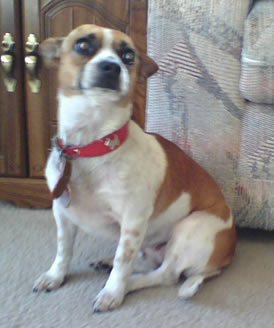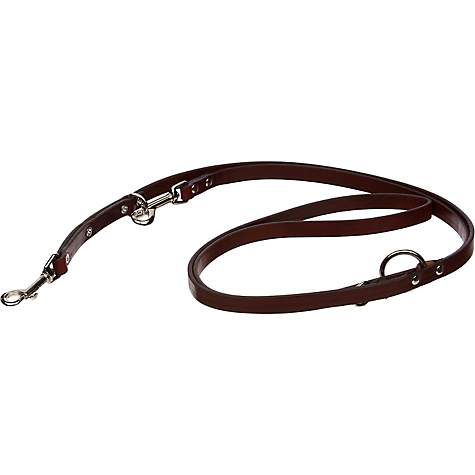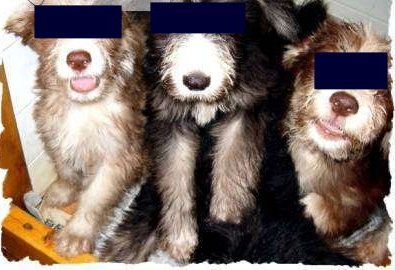Dog Registries and What they Do...
Or should I say, what they DON'T do. When you buy a purebred puppy (that's the correct term - not full bred, thoroughbred, or anything else - and dogs have CHAMPIONS not Grand Champions - that's for horses...) it will no doubt be registered with some entity. The most common and popular in the United States is the AKC (American Kennel Club).In Canada it's the CKC (Canadian Kennel Club). In spite of my beef that they don't do enough to put an end to puppy mills and show mills (a new word I've heard for show kennels that breed too much), they are the "Standard" and oldest clubs around and if by no more than reputation, are the ones you want your dogs registered with. What do they do, you ask? Not as much as you'd think. They are basically a pedigree registration entity and for a very long time have sponsored dog shows so that breeders can get together and compare, judge and improve their breeding stock. That is their main purpose. It's not to make sure you have a healthy dog. It's not to make sure you have an ethical breeder. It's not to even make sure the dogs in your pedigree are who they say they are, though they do make a miniscule effort by requiring DNA tests on popular stud dogs and spot checks on some kennels. At least it's something.
AKC papers are just that - PAPER. The AKC stays in existence to collect fees from breeders and issue paper pedigrees - in essence, they keep the geneaology of our dogs. Then, with all this money they collect registering dogs, they help local clubs put on shows. They mainly do the administrative work involved in keeping records for THAT...such as who won, who bred to who, tell us which breeds they agree ARE purebred, telling us which dogs won enough to be "Champions" and to certify judges. They don't educate the judges - local clubs do that. They don't keep the actual breeder's records - the breeder does that. They just accumulate all this information, and for a fee, maintain huge directories of dog pedigrees, judges and wins, and with this information help local clubs put on dog shows.
So what is the UKC? The UKC is another new up and coming registry. Mainly they do the showing aspect of purebred dogs. The UKC has different rules for it's dog shows and some feel these are less stringent and a lot more fun. Some examples are it's easier to become a UKC champion and judge, they don't allow food in the ring (to bait the dog so it looks perky), and the clothing and atmosphere is more relaxed.The consensus in the dog world is that if you can't win with AKC, you try UKC to get those titles. And while many very nice dogs compete in both, AKC is acknowledged to usually be more difficult to complete a championship in.
It's acknowledged AKC has more snob appeal than UKC, but which is better probably depends on your definition of better. Personally, I feel do whatever you enjoy - Does it matter what title your dog gets if you enjoyed the trip getting there? I can sympathize with many UKC participants that have been burned by the AKC and the elitist AKC attitude many harbor that do a lot of AKC winning - would you stick around a club that makes it difficult for you to win? Treats newbies like step-children? A club with a lot of snobbery? Of course not, so you go to the UKC where rules are a bit more relaxed, where you can actually have FUN showing. So far we are AKC participants, and there's no reason we can't go to UKC shows...but AKC is just what we choose to do. My point being, AKC, CKC, UKC, they are all legitimate clubs and registries.
Very outgoing, fluffy and super sweet male Husky-Poo! We call them Siberian Doodles! UKCI registered. THis male has 1 blue eye and 1 brown eye. He will be approx. 45 lbs. as an adult. Gets along with other dogs. Very gentle and playful. Silver and white. Serious inquiry only please. This male is $200 + 7% NC sales tax firm. We do ship! xxx-xxx-xxxx This is a REAL ad... The dogs identities are hidden to protect the innocent dogs...note how the pups look more like the poo than the husky, perhaps there were some husky looking pups that didn't resemble the poo side too since only 3 are shown...they don't breed true as you see no characteristics of the husky here, and this is only the first generation. It would be interesting to see the F1 (or progeny's generation) and see what they look like. |
Then there are the quasi-registries. These will give ANYTHING with 4 legs a pedigree. While the AKC and CKC make an effort to actually spot check breeders and only give recognition to dogs of "real" breeds (and have pretty strict criteria as to what a breed IS)- a few others such as ACA, UKCI, APRI will give your hamster a pedigree (you can call it a miniham and create your own dog breed). This is often where mixed breed breeders and puppy mills are obtaining their "pedigrees". When you hear of a "Labradoodle" or "Schnoodle" with a pedigree, odds are this is where they obtained them. Send your money, create a new breed. While AKC (and CKC and UKC) breeds go through a long process to be recognized as a true breed, these quasi-registries have no such requirements.
A dog breed is not just what someone decides it is.It all goes back to genetics.While many breeds came from other breeds, our Malamutes, being a "natural" breed are not like this. However, it's important to know that many breeds indeed did start as mixes of 2 or more other breeds. Nothing wrong with that. (I LOVE mixed breeds myself - my first dogs were a whippet mix and a rat terrier mix). But the key here is, mixes do not breed true. If you mix a chow and a poodle (we'll call them "choodles") - Do they breed true after that first generation? In other words, if you breed two "choodles" do you get baby choodles? A true purebred dog will do this....in fact they will continue to breed true even after several generations of throwing in other things.For example, if you take a Malamute and were to breed it with a poodle mix - first generation (their puppies) would be a strange mix of poodle stuff and mal. However, say you bred the "moodles" to Malamutes. Suddenly you'd see all the puppies look WAY more like Malamutes than poodles. Within one more generation you wouldn't even know there were poodles in there.The term for this is homozygous - in other words, the mal genes (due to years of breeding mal to mal) are so "strong" for Malamute genes, you can throw something totally unrelated into the mix and they'll come out looking, acting and being Malamutes. This is not true for a mix. Every generation will look more and more "mixed" - some puppies taking mom's characteristics, some taking dad's. To bring it back to our choodle example, second generation of our choodles will sort out to look either like chows or poodles - not retaining the characteristics of both mixed. Choodle to Choodle will not produce Choodle - it will produce Chows and Poodles (and not very nice ones at that). Why? Because Chows are a "breed" and Poodles are a "breed" but Choodles are not! This is how registries (at least the legitimate ones) determine what is a true breed - when it breeds true! If our Choodles consistently produce more Choodles, and the Choodles kids produce consistently similar Choodles - after a few generations we can probably say we have a new breed! A committee will be formed to examine the results and pedigrees - and a determination made as to whether Choodles are really a breed. (Warning: do not try this yourself! There are already too many dogs without homes out there and nobody remembers who created a breed anyway, so if you're looking for fame and fortune - take up something else!)
Which brings us to "designer dogs". This is a new sales gimmick. In my grandmother's day, mixes were the norm. Only the rich had "purebred" dogs. The rest of us had mutts. The word mutt has increasingly become unpopular in favor of politically correct terms - random bred, designer pets, etc. But folks, that's what designer dogs are - MUTTS.It's someone with a Labrador and Poodle that decided to make a few bucks and take advantage of the lack of mutts, now that purebreds have become much more affordable. It's the pendulum swinging - mutts to purebreds and now we're going back to mutts. But of course you don't want to look less haute couture than your neighbor, so you call it a designer dog. My mom has a designer dog - Rosie is a mutt (and my Mom knew this when she got her) but some unscrupulous breeder could have sold her for big bucks by marketing her as a designer dog - a daschund chihuahua mix or a Doxiuahua...doesn't that sound so much more impressive than MUTT????? The unsuspecting public, fools that we are, then pay big bucks for this new "breed" - which isn't a real breed at all. If the "breeder" wants to lend some legitimacy to his scam, he'll get papers for his Doxiuahua from one of the quasi-registries and say it's a rare breed with papers. So what does this REALLY make the dog....a mix, a mutt - and you a FOOL for paying big bucks. Not that mixes aren't great dogs. Rosie is  WONDERFUL, she's a fantastic little dog that my parents adore. She was the best dog for their situation and fits in perfectly. But she's not a purebred dog, and all the papers in the world from some quasi-registry won't make it so unless someone can prove the Doxiuahua will breed true - and they don't.
WONDERFUL, she's a fantastic little dog that my parents adore. She was the best dog for their situation and fits in perfectly. But she's not a purebred dog, and all the papers in the world from some quasi-registry won't make it so unless someone can prove the Doxiuahua will breed true - and they don't.
So why do we need papers if we aren't going to breed? We don't. But what you are paying for and why real purebred dogs cost more than mutts is because you are paying for all the work that went before. The consistency of what will come from the litter. While Malamutes being a natural breed are less likely to be cookie cutter than other breeds, they are still "Malamutes" - every single one. You will get the counter-surfing, massive shedding, smart dog you know and love and EXPECT.
You are getting all the litters that did breed true, the mistakes, the testing, the weeding out of genetic defects....and how do we know this? Because the AKC or CKC (and there are other legitimate registries in Europe, Australia, etc. so do your research!) tell us who are the dogs behind our dogs. They've kept the records the reputable breeders gave them and have passed them on to the new breeders, and on and on. And as I've said before, your papers are only as good as the breeders behind them. If you buy a pup from someone known to be sloppy, or from lines known to be badly bred, your "papers" might as well be toilet paper. On the other hand, if you've done your research and know what lines are from reputable breeders and those are in your pedigree, you can be sure the AKC has collected good information for you - to base your puppy purchase decision on.
The AKC does not do much in the way of guaranteeing you anything except that they have kept the lines for you so that you will know if there are reputable people behind your dog. They have started adding genetic testing info (such as DNA, CERF and OFA info) to pedigrees. I think this is an excellent start because 25 years from now, someone with an AKC pedigree will know that his dog's ancestors hips were good or excellent back 25 years....but that's still something of a pipe dream until everyone submits their information so that AKC can catalog it. And it will never stop the unscrupulous breeders from breeding husky-poos. So it's up to an informed public to understand just what they are buying. As for the other things that make up a great puppy? Temperament, good with kids, easily trained, etc. I think we'll have to wait awhile for genetic tests on that one.
No one can guarantee those things and it looks like it will be a long time before they can. So maybe you should get a Labradoodle or Doxiuahua - but don't pay for papers and don't pay for years of "breeding true" that doesn't exist - get your designer dog from the pound. There are many wonderful designer dogs there waiting for homes at reasonable prices. Even a few "Alaskan Huskies" (yes, those are MUTTS too!)....











